This homemade orange cake is light, moist, and packed with bright citrus flavor. Sweet-and-tangy cream cheese frosting is the perfect finishing touch!
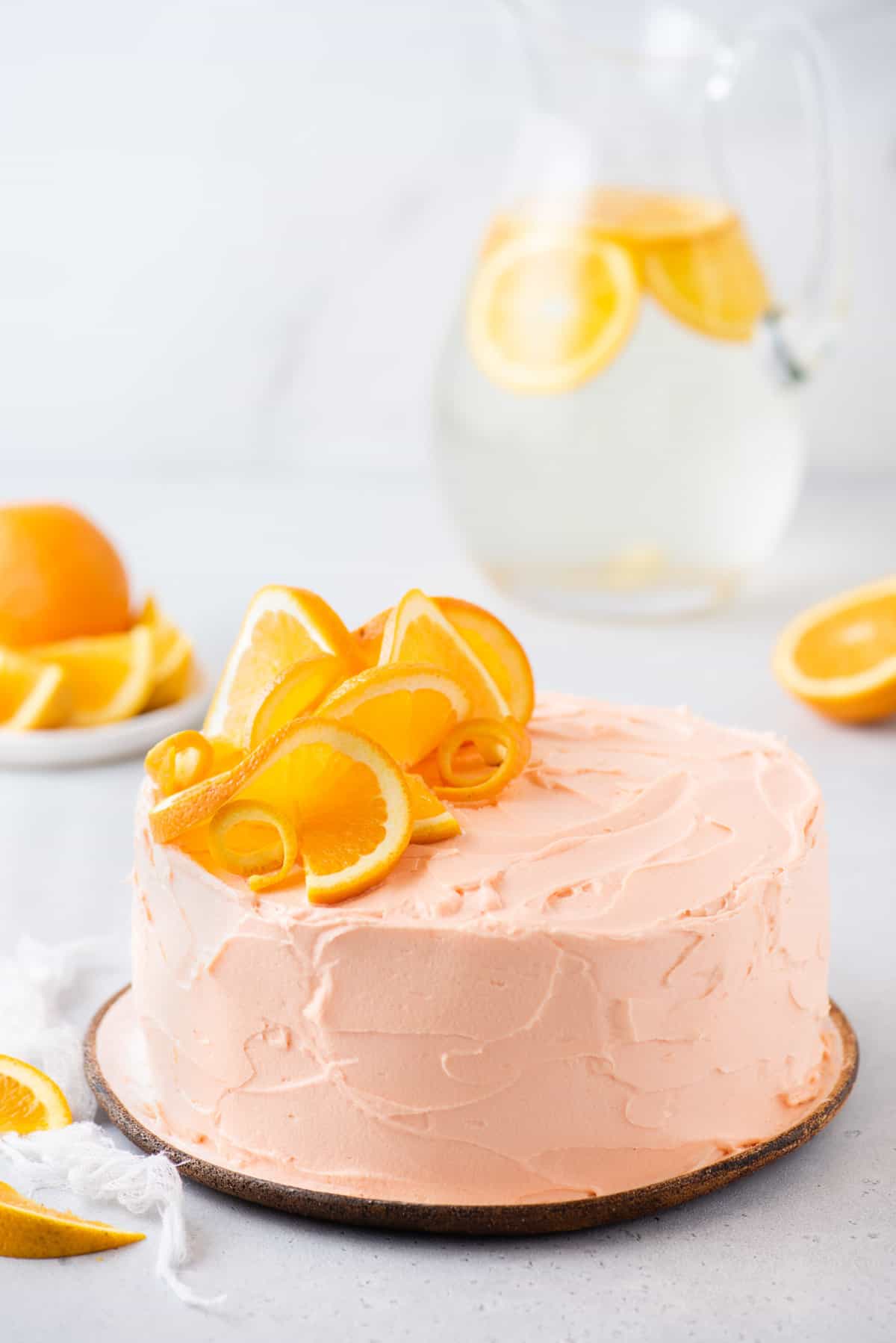
If you love lemon cake, give our fresh orange cake recipe a try! It uses freshly grated orange zest to give the cake a bright citrus flavor.
If you have extra oranges laying around, use them to make Orange Muffins or Orange Cranberry Granola.
IN THE POST WE WILL COVER:
- How to properly measure flour
- How to prepare a cake pan
- Recommended cake baking tools
- How to bake flat even cakes
- Total time required
- How much frosting to put in between cake layers
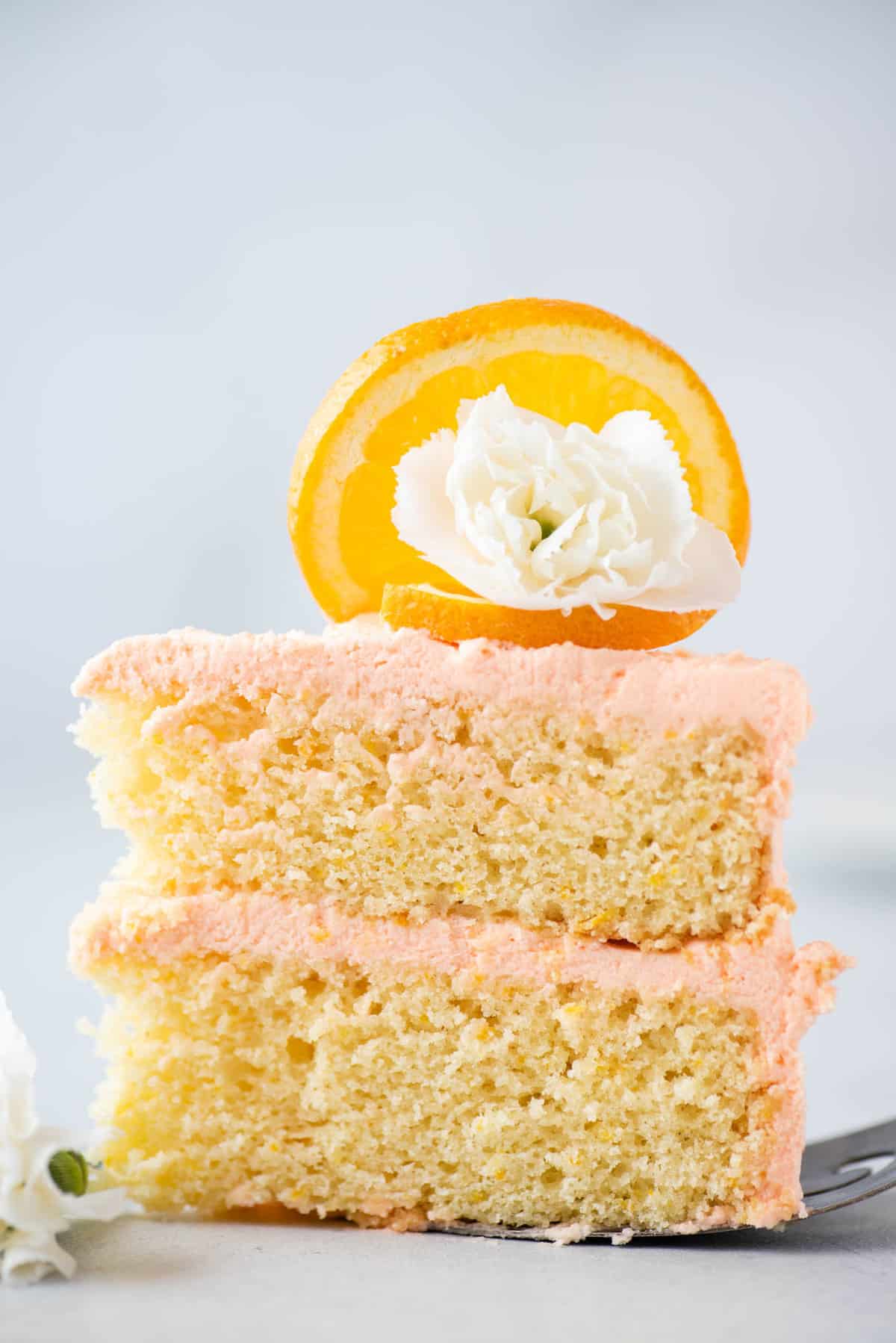
How to Properly Measure Flour
- Fluff the flour with a fork or whisk
- Use a spoon to scoop the flour into your measuring cup
- Use a butter knife to level off the flour in the measuring cup
Sticking the measuring cup straight into the bag of flour will result in too much flour to be packed into the cup, which can result in dry cake.
How to Prepare a Cake Pan
I recommend greasing your cake pan with butter or shortening, not non-stick cooking spray. Liberally butter the entire pan. I find that butter works better to grease the pan to ensure the cake doesn’t stick.
Place your hand inside a ziplock bag or paper towel, use 1/2 tablespoon of butter or shortening and liberally butter the pan. The bag or paper towel will prevent the butter from getting all over your hands.
For super easy cake removal, cut out a circle of parchment paper that is the same size as your pan and place it in the bottom of the pan after you buttered it. I trace the bottom of my springform pan onto the paper, then cut it out.
Recommended Cake Baking Tools
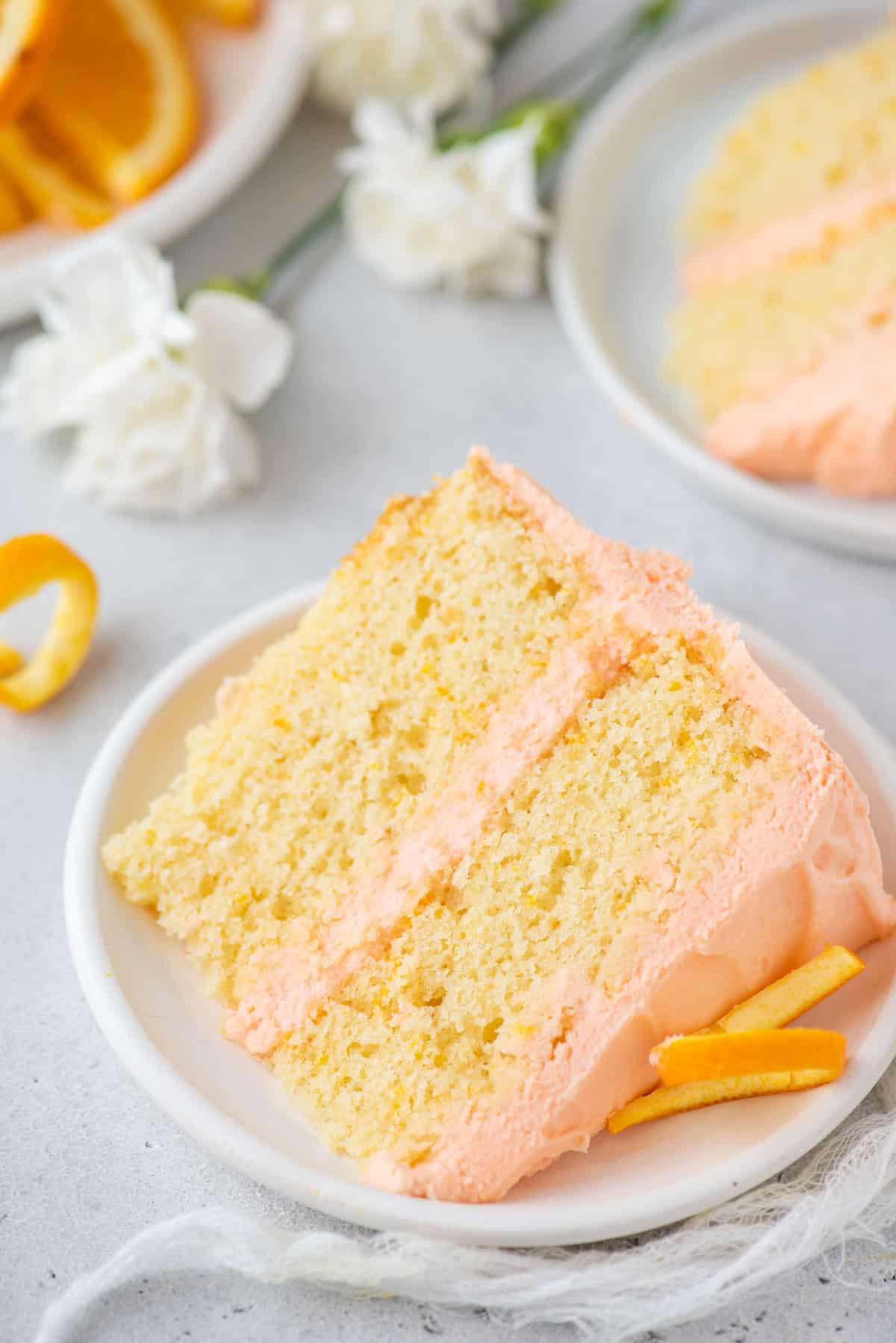
What You’ll Need
Note that you’ll also need two 8-inch round cake pans or springform pans for this recipe. Be sure to scroll down to the recipe card for specific amounts.
FOR THE ORANGE CAKE LAYERS:
- All-purpose flour
- Finely grated orange zest
- Baking powder
- Unsalted butter – Let this come to room temperature before starting the recipe.
- Granulated sugar
- Eggs – Let the eggs come to room temperature, too. Room temperature eggs hold more air when beaten, which means a lighter, fluffier cake.
- Vanilla extract
- Milk – Use either 2% (reduced-fat) or whole milk.
FOR THE CREAM CHEESE FROSTING:
- Unsalted butter – This should also be room temperature so it’s easy to whip into a creamy, dreamy frosting.
- Cream cheese – Use 12 oz total of brick cream cheese
- Vanilla extract
- Powdered sugar – Also known as confectioners’ sugar.
- Light orange food coloring – optional, but tinted the frosting a pretty light orange color! I used AmeriColor brand.
THE BEST WAY TO JUICE AN ORANGE
Roll the orange on the counter under the palm of your hand. Cut the orange lengthwise, then use a lemon reamer or juicer to break up the membranes while holding the orange firmly, squeezing out the juice as you ream.
How to Make Orange Cake
A two layer cake is a good place to start if you’re new to making layer cakes. Plus, you can divide the hands on time into two days if you don’t have time to fully assemble the cake in one day.
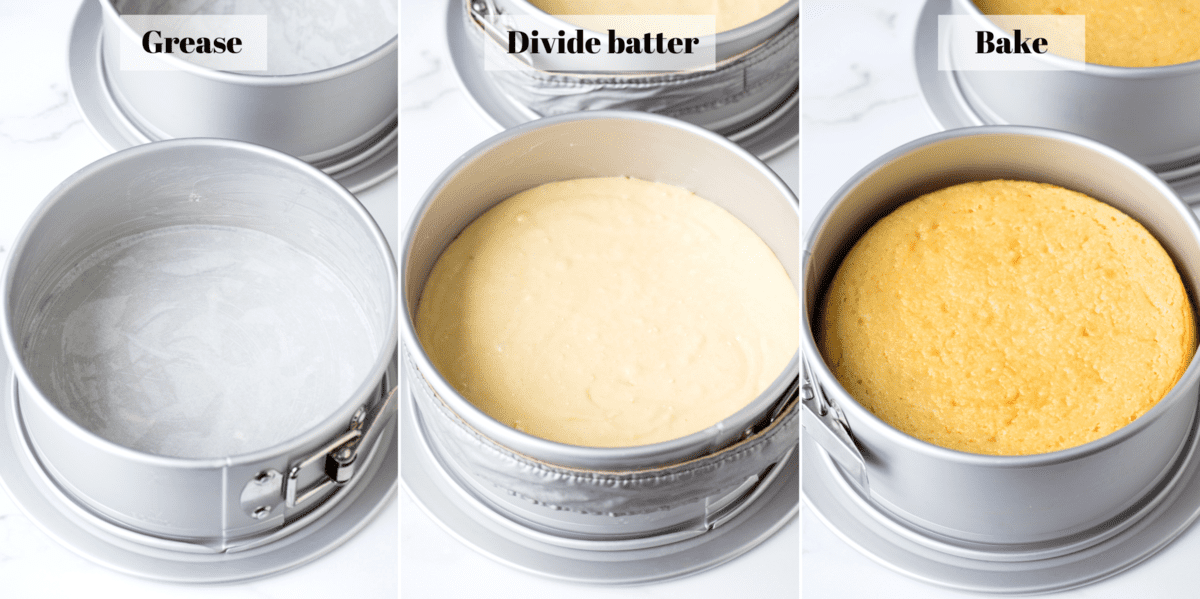
MAKE THE LAYERS:
Prepare. Preheat your oven to 350ºF and grease the bottoms and sides of two 8-inch round cake pans or springform pans, then line the bottoms with round pieces of parchment paper.
Mix the dry ingredients. In a medium mixing bowl, whisk together the flour, orange zest, baking powder and salt.
Mix the wet ingredients. In a large mixing bowl, beat the butter and sugar with an electric mixer on medium-high speed until they’re fluffy. Then, beat in the eggs one at a time, followed by the vanilla extract.
Combine the wet and dry ingredients. Reduce the mixer speed to low. Add the flour mixture to the wet ingredients in 3 additions and the milk in 2 additions, beginning and ending with the flour.
Bake. Divide the batter into the prepared cake pans (about 2 & 1/2 cups per pan), spreading it evenly with a spatula. Bake the cake layers for 30 to 34 minutes, or until a toothpick inserted into the centers comes out clean.
Cool. Let the cakes cool in the pans on cooling racks for 10 to 20 minutes, then carefully remove the cakes from the pans and let them finish cooling directly on the racks. Once cool, remove the parchment paper from the bottom of the cakes.
Prep for assembly. If you need to level the tops of your cakes, do so now using a cake lever or serrated knife. Wrap the cakes in plastic wrap and refrigerate them for up to a week.

MAKE THE FROSTING:
Beat the butter and cream cheese. In a large mixing bowl, beat the butter and cream cheese with an electric mixer on medium-low speed until it’s light and fluffy.
Add the remaining ingredients. Beat in the vanilla extract and the powdered sugar, starting with 2 cups. Continue adding the powdered sugar until the frosting reaches your desired thickness and sweetness, beating on low until fluffy and smooth. Add light orange food coloring if you want the frosting to have a pale orange color.
PUT THE ORANGE LAYER CAKE TOGETHER:
Stack the cake layers. Spread a small amount of buttercream on an 8-inch round cardboard circle set on a turntable or cake plate. Place the first cake layer on top of the cardboard. Spread about 1 cup of buttercream on top of this layer, then place the next layer over the buttercream. Repeat for each layer.
Do a crumb coat. Once all of the layers are stacked, use an offset spatula to spread a thin layer of buttercream around the sides of the cake. Refrigerate for 20 minutes.
Finish frosting. Use an offset spatula to spread the rest of the frosting onto the cake once the crumb coat is chilled.
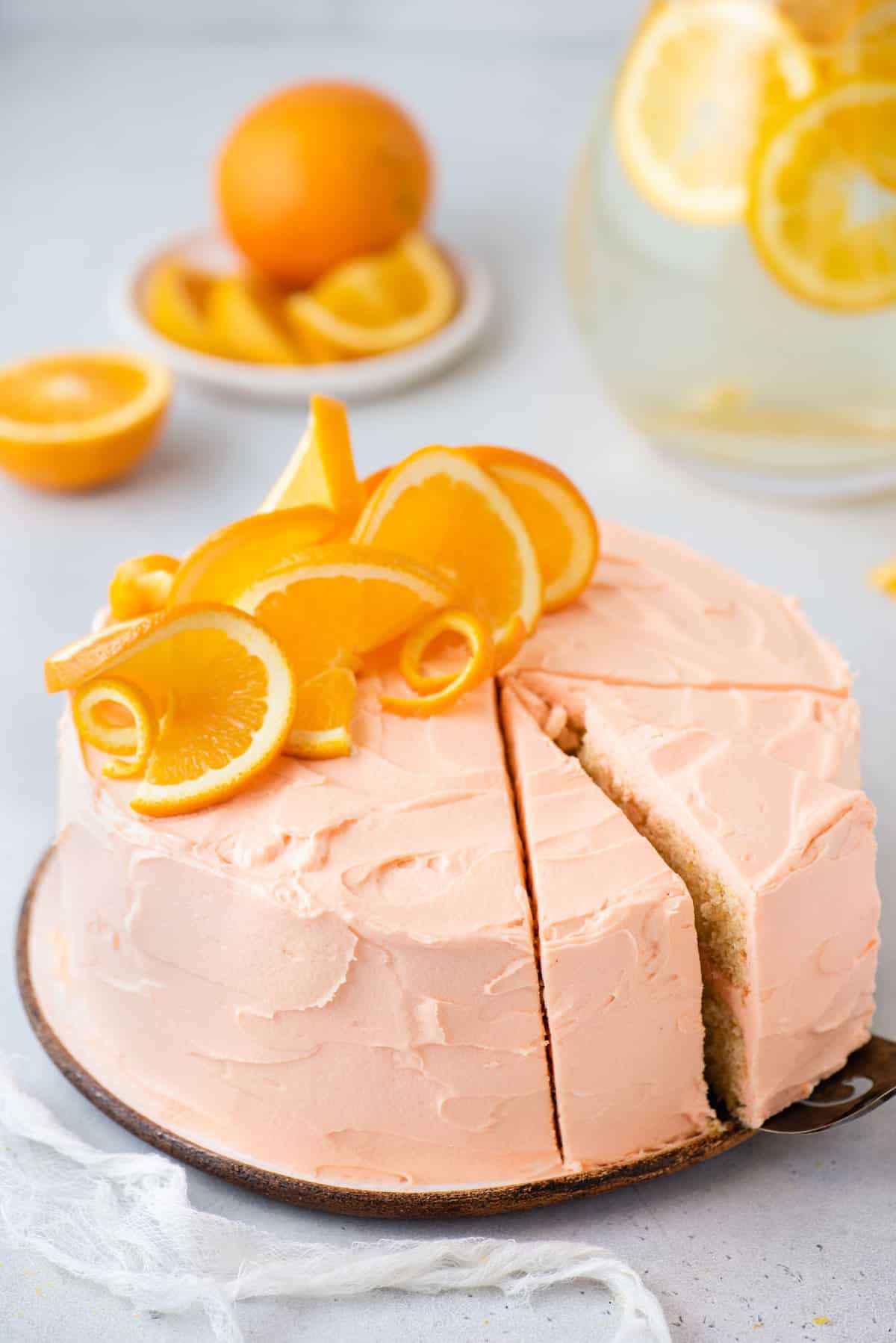
How Much Frosting Between Cake Layers
For an 8 inch 2 layer cake chocolate cake I recommend 3/4 to 1 cup of frosting between the cake layers. The remaining frosting will be used to frost the sides and top of the cake.
Total Time Required
- 15 minutes to prep the batter
- 30-34 minutes to bake
- 1+ hour to cool the cake completely
- 5 minutes to make the frosting
- 10-20 minutes to assemble and frost the cake
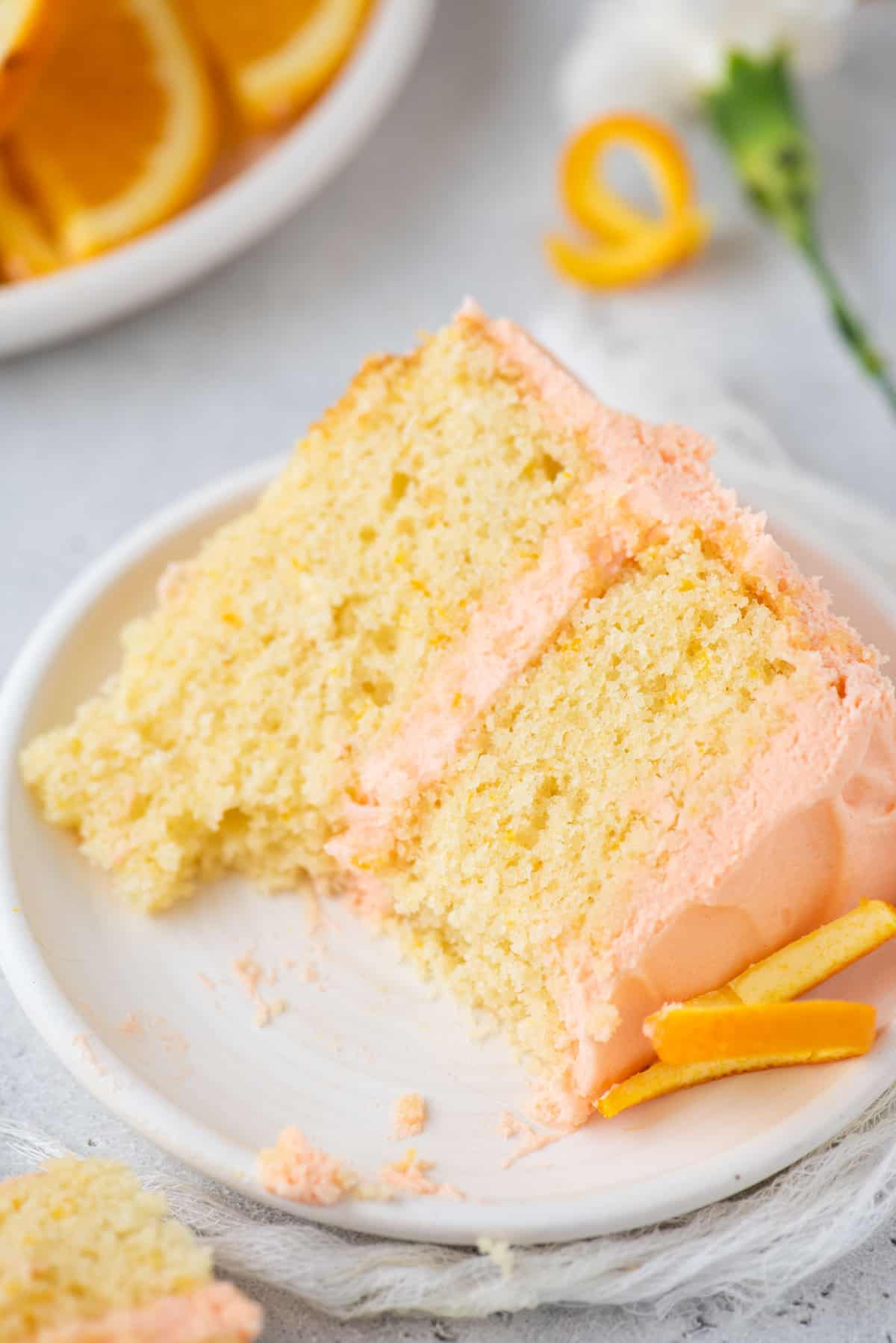
Expert Baking Tips
These hints and tips will help make sure your cake turns out perfect!
- How To Bake Even Flat Cakes. Use a bake-even strip. This will ensure even baking; make your own homemade bake-even strip using a towel or old t-shirt cut to fit the size of your pan. Soak the fabric in water, then squeeze out the excess. Secure the fabric strip around the pan with a safety pin.
- Don’t let the cakes cool too long in the pan. Although you might think a longer cooling time will make the cakes easier to remove, the opposite is true! 10 to 20 minutes is the perfect amount of time.
- Making smooth sides. If you’d like super-smooth, bakery-style sides on your cake, simply run a bench-scraper along the frosting on the sides.
- Adding the perfect finishing touch. I used fresh orange slices to decorate this cake, but edible flowers, fresh berries, candied oranges or piped frosting would work, too.
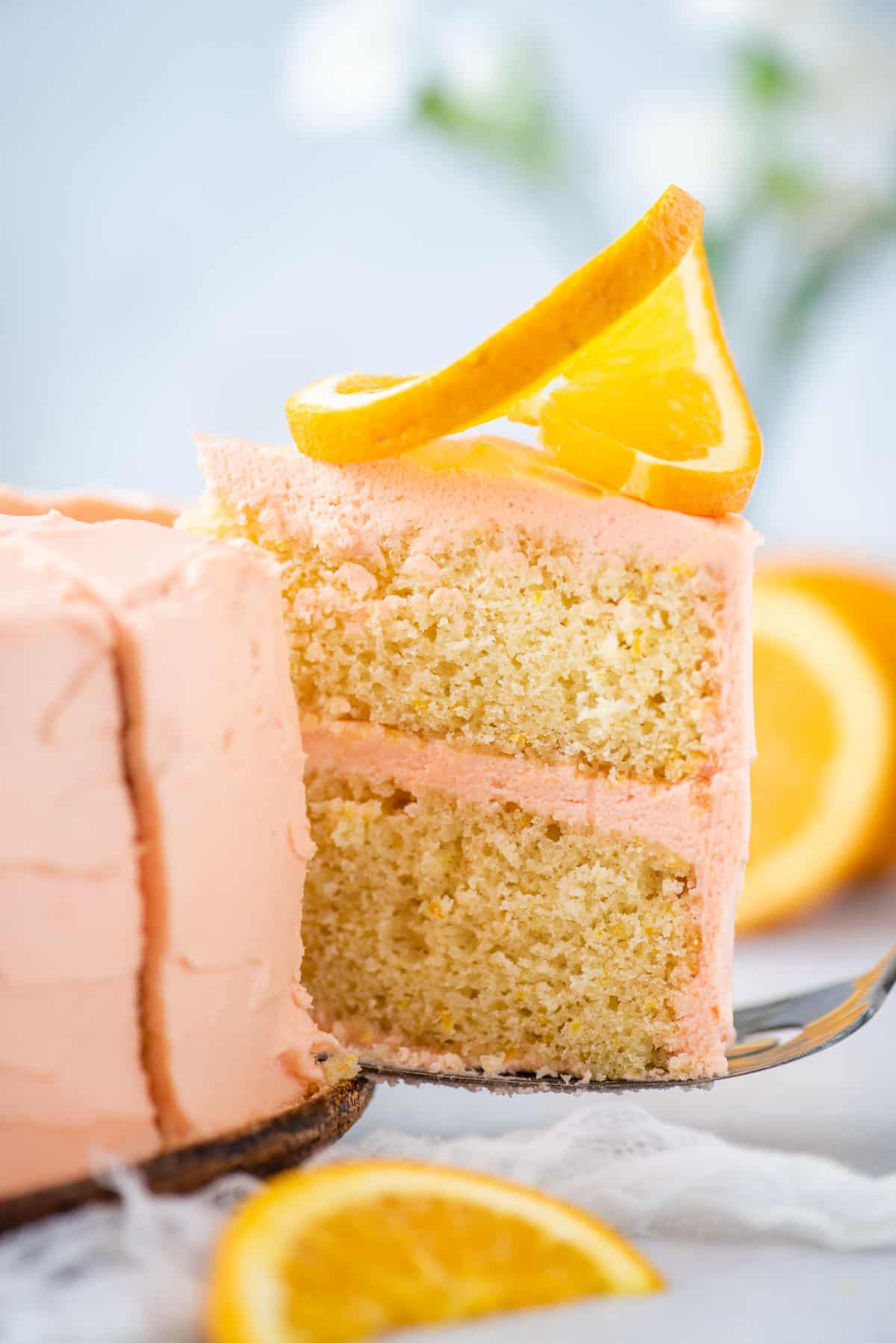
Storage Instructions
This orange cake recipe can be left at room temperature for up to 3 days. Loosely cover it with plastic wrap or store leftovers in an airtight container.
Can I Freeze This?
Yes, you can freeze this cake. If you’re freezing a whole cake, set it on a sheet pan and place it in the freezer uncovered. Once the buttercream has frozen completely, tightly wrap the cake in a few layers of plastic wrap and return it to the freezer.
To freeze leftover cake slices, place them in an airtight container or freezer bag with parchment paper between pieces if you have to stack them.
Thaw the cake in the refrigerator before serving; if you’re thawing a whole orange cake, be sure to loosen the plastic wrap so it doesn’t stick to the frosting as it thaws.
Variations
Here are some ideas for switching things up with your orange layer cake!
- Add poppy seeds. Turn this into an orange poppy seed cake by adding 2 tablespoons of poppy seeds to the batter.
- Make a blueberry-orange cake. Toss blueberries with a small amount of flour and fold them into the batter. The flour keeps the blueberries from sinking!
- Add a filling. Instead of frosting between the layers, you can use orange curd, custard, or a berry filling.
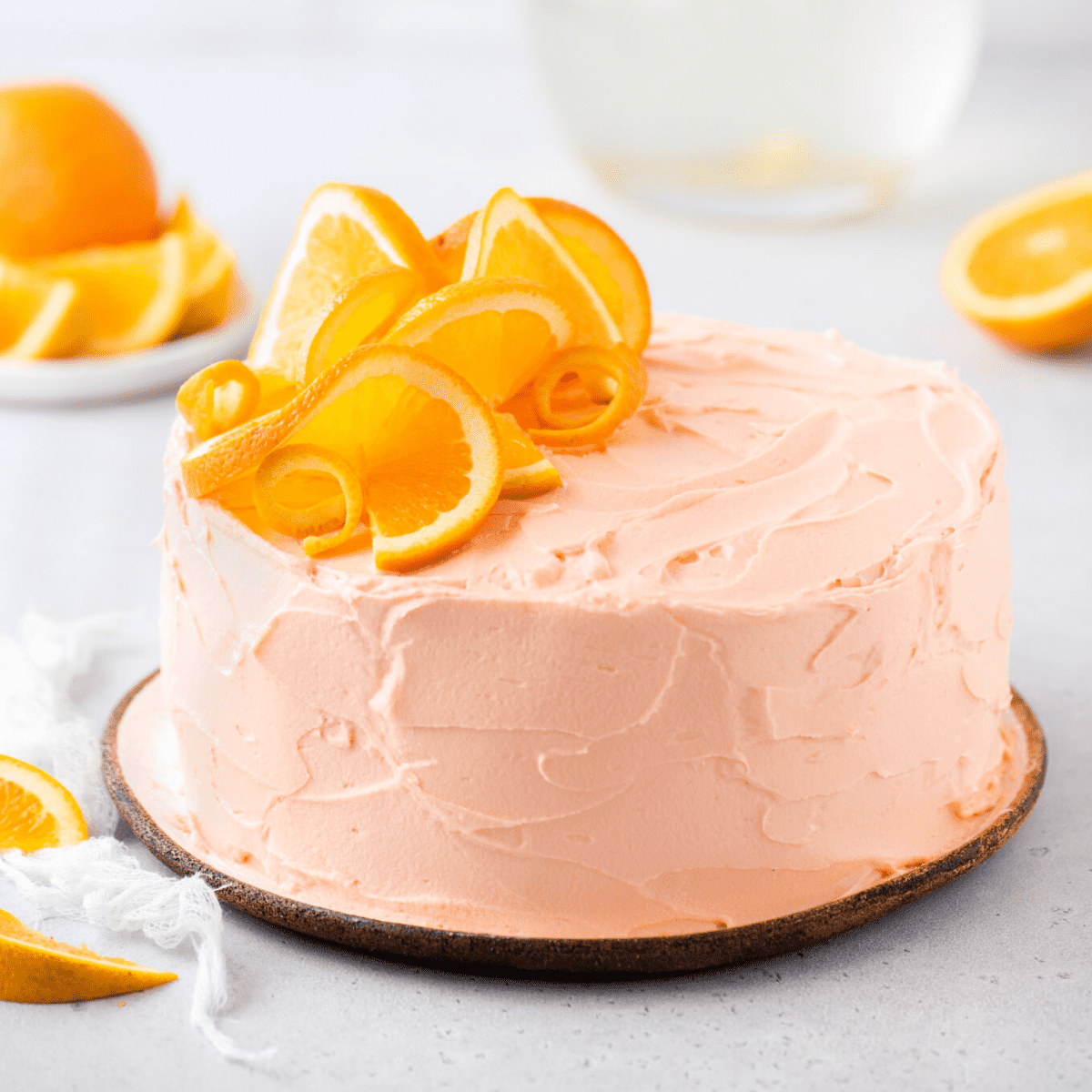
Orange Cake
Ingredients
Orange Cake
- 3 cups all purpose flour
- 3 tbsp finely grated orange zest (about 1 large orange)
- 3 tsp baking powder
- ½ tsp salt
- 2 sticks unsalted butter room temperature (1 cup)
- 1 ½ cups granulated sugar
- 3 large eggs
- 2 tsp vanilla extract
- 1 cup milk 2% or whole
Cream Cheese Frosting
- 2 sticks unsalted butter room temperature (1 cup)
- 12 oz cream cheese room temperature (1 & 1/2 bricks)
- 1 tsp vanilla extract
- 2-3 cups powdered sugar
- Light orange food coloring optional – I used AmeriColor brand
Instructions
Orange Cake
- Preheat the oven to 350 degrees F. Grease the bottom and sides of two 8 inch round cake pans or springform pans with butter and line the bottom of each pan with a round piece of parchment paper. To ensure even baking, place a bake even strip around the pan. Set aside. You can also use three 8 inch pans for this recipe to make a 3 layer cake.
- In a medium bowl, whisk together the all purpose flour, orange zest, baking powder, and salt, set aside.
- Using an electric mixer, beat the butter and sugar on medium-high until fluffy, 2 to 3 minutes. Beat in the eggs and vanilla extract, scraping down the sides of the bowl as needed.
- Reduce mixer speed to low and add the flour mixture in 3 additions and the milk in 2 additions, beginning and ending with the flour mixture. Mix on low just until combined.
- Divide the batter evenly among two pans, with about 2 & 1/2 cups batter in each pan. If dividing the batter among 3 pans, put about 1 & 3/4 cups in each pan. Place the pans in the oven. For two 8 inch pans bake for 30-34 minutes or until a toothpick inserted in the center comes out clean. For three 8 inch pans bake for 23-27 minutes or until a toothpick inserted in the center comes out clean.
- Once the cakes are done, allow them to cool in the pan on a cooling rack for 10-20 minutes. After cooling, carefully remove the cake from the pan. If using a springform pan, remove the sides and bottom. Allow the cake to cool completely on a cooling rack. Once cool, remove the parchment paper round from the bottom of the cake. If you need to level the top of your cakes, do so now using either a cake lever or knife. If you’re assembling the cake later, wrap each cake layer really well in plastic wrap and place them in the refrigerator, for up to 3 days.
Cream Cheese Frosting
- Place the room temperature unsalted butter and cream cheese in a mixing bowl. Use an electric mixer on medium and beat together for 1-2 minutes, until whipped and fluffy.
- Add in the vanilla extract, powdered sugar, and optional light orange food coloring, beat again on low for 1-2 minutes, scraping down the sides of the bowl, until everything is incorporated.
- If the frosting is too thick, add a splash (1 tablespoon or less) of milk or heavy cream, beat until creamy.
Assemble
- I like to assemble my cakes on a turntable. Spread a small amount of frosting on a 8 inch round cardboard circle or cake plate if skipping the cardboard circle. Place the first layer on top of the cardboard, lightly push down to adhere the cake to the frosting.
- Evenly spread 1 cup frosting on top of the first layer.
- Add the second layer of cake, lightly pushing down. Now, it’s time to do a crumb coat. The crumb coat will help seal the crumbs in. Using your offset spatula, spread a thin layer of frosting around the sides and top of the cake.
- Place the entire cake in the fridge for 20 minutes.
- Spread the remaining frosting on the sides and top of the cake. Add fresh orange slices for decoration. Slice and serve. Cover leftover cake tightly with plastic wrap and store on the counter for up to 3 days.
Notes
- Fluff the flour with a fork or whisk
- Use a spoon to scoop the flour into your measuring cup
- Use a butter knife to level off the flour in the measuring cup
Nutrition
The post Orange Cake appeared first on The First Year.
